3019PSY Module 7 Disorders of Everyday Action
1/63
There's no tags or description
Looks like no tags are added yet.
Name | Mastery | Learn | Test | Matching | Spaced |
|---|
No study sessions yet.
64 Terms
everyday actions
actions we do all the time without really thinking about it
top down guidance
requires access to stored information, which involves higher-order processes
bottom-up processes
noticing cues in the environment relevant to the task, and ignoring those that arent
executive functions
higher order processes that control and regulate behaviour
functional independence measure (FIM)
assesses whether a person can physically complete daily movements and a few cognitions
instrumental activities of daily living scale (IADLS)
measures ability to carry out complex everyday tasks (eg shopping, managing finances) either from the clients perspective or those close to them
multiple objects test (MOT)
assessed planning and execution of everyday tasks while the patient is completing the task (eg wrapping a present)
multi-level action test (MLAT)
an extension of the MOT that uses naturalistic tasks (eg making toast with butter and jam) while noting the number and types of errors made
naturalistic obersation test (NAT)
assesses for naturalistic action impairments and rates the severity of the problem; shorter and more simplified scoring than the MOT and MLAT
action disorganisation syndrome (ADS)
where a patient has difficulty performing routine, everyday, multi-step tasks not due to a motor or object recognition deficit
object substitution errors
using objects innapropriately even when the patient knows what it is
omission errors
leaving out actions needed to complete a task
addition errors
adding in extra uneccesary actions when completing a task
wrong order errors
completing the steps of a task in the incorrect sequence
preservation errors
repeating the same step of a task multiple times uneccesarily
wrong spatial plane errors
using a tool in the wrong spatial plane while completing a task
action coding scheme
suggests that multi-step tasks are performed in a hierarchical; split into A2 and A1 tasks
A2 tasks
the larger goal of the action, generally split by the objects needed to perform the task
A1 tasks
the sub-steps of the A2 tasks
place and object substitution errors
putting an object in the wrong place
anticipation errors
performing actions in the wrong sequence
tool substitution errors
using the incorrect tool for the given task
quality error
performing an action correctly but clumsily
omission error
forgetting a step of an action sequence
competitive queuing model
proposes a hierarchical model of action execution comprising of a goal unit, basic level components, and object representations
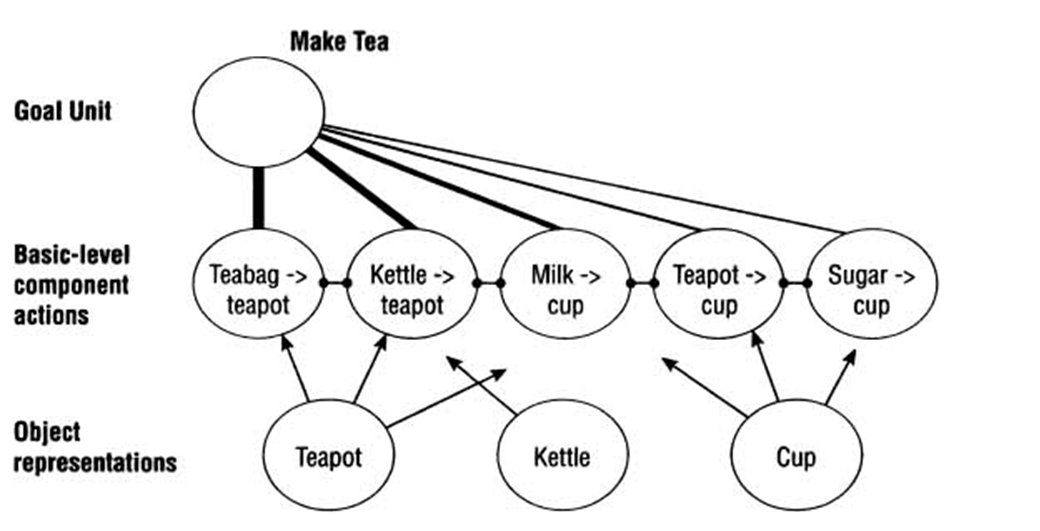
competitive queuing model explanation for object substitution errors
impaired connection between object representations and basic level components; impaired top-down activation of the goal unit
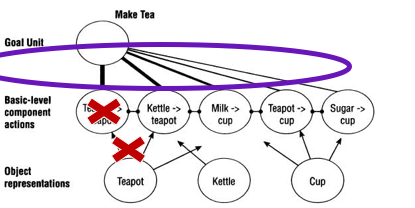
competitive queuing model explanation for omission errors
impaired activation from the goal unit to basic level components
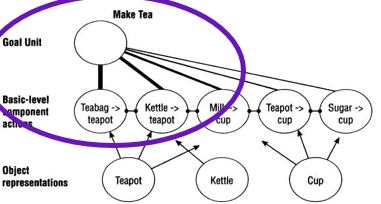
competitive queuing model explanation for preservation errors (immediate preservations)
impaired links between basic level components
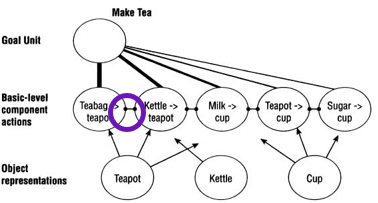
competitive queuing model explanation of preservation errors (delayed preservations)
impaired activation gradient bewteen goal unit and basic level components
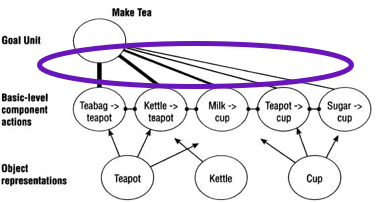
competitive queuing model explanation for stored knowledge impairments for routine actions
impaired long-term knowledge of action sequences / goal units
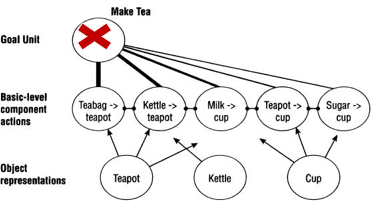
utilisation behaviour disorder (UBD)
intact actions for using objects, but using them in innapropriate contexts
toying
object manipulation that is not purposeful or useful (eg picking up a pencil without using it)
complex toying
using 2 objects in a related but unintended way (eg pushing a wiiden block with a pencil)
normal & shallice model of control and action control
explains how humans regulate and control their actions, particularly in complex or novel situations
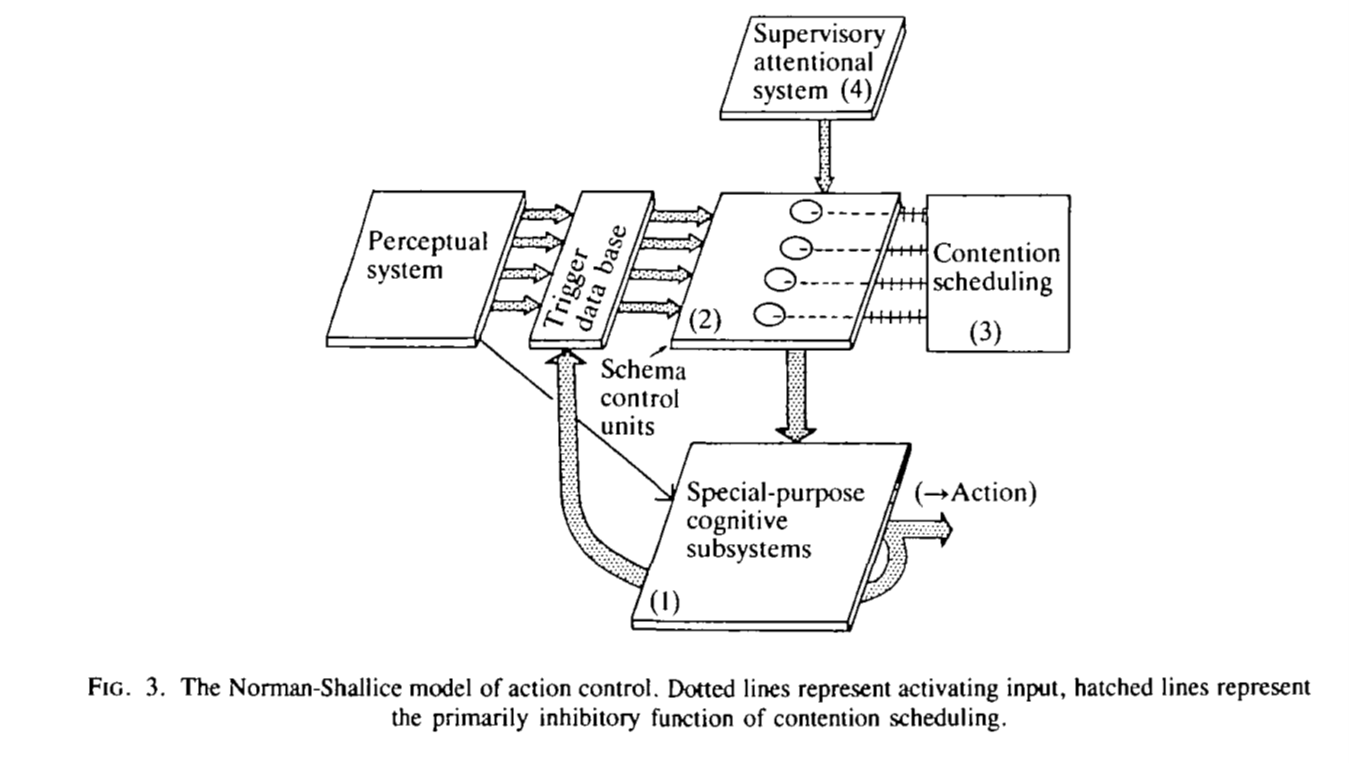
special purpose cognitive subsystems
a series of actions we all know how to do (eg object recognition)
schema control units
the programs that run certain behaviours based on information coming from the special prupose cognitive subsystems
triggers
perecptual inputs/ outputs of other schemata that activate new schemata
contention scheduling system
a system that chooses which schemata to control behaviour out of competing ones that are activated
supervisory attention system
active in novel situations when the active schemata dont provide an appropriate response, and either activates/ inhibits these schema more to ensure the appropriate actions are carried out
frontal lobe damage
associated with UBD; inhibits the supervisory attention system
apraxia
higher order disorders that causes the loss of ability to perform well-learned pruposeful movements, not due to motor, comprehension, or cooperation deficits
ideomotor apraxia
disorder in the planning and sequencing of actions as well as generating and controlling the motor activity necessary to perform them; with normal conceptual praxis
ideational apraxia
disturbance in the conceptual organisation of actions resulting in a loss of knowledge about how to use tools
conceptual apraxia
a type of ideational apraxia involving semantic errors in performing single actions, common in people with Alzheimers
conduction apraxia
patient is better at actioning gestures for verbal commands compared to mimicking someone elses
visuo-imitative apraxia
an extreme form of conduction apraxia where a person has normal ability actioning gestures for verbal commands but cannot mimic those of someone else
constructional apraxia
issues spontaneously drawing, coping drawings, or constructing objects with wooden blocks
oral apraxia
inability to perform mouth movements
ocular apraxia
impaired saccadic eye movements
speech / verbal apraxia
problems with word articulation
limb-kinetic apraxia
slow, stiff movements; loss of fine motor movements in the fingers
developmental apraxia
apraxia in children
visuo-motor apraxia
disruption of actions requiring visual support (eg reaching for and grasping a cup)
dressing apraxia
issues getting dressed
mirror apraxia
inability to reach for objects in a mirror / using a mirror correctly
Roy & Square (1985) model of limb praxis
proposes the conceptual and production systems of limb praxis, predicts ideational apraxia is caused by deficits at the conceptual, and ideomotor apraxia by deficits in the ideomotor systems
conceptual system
processes abstract representations of actions
production system
incorporates sensorimotor representations of action and mechanisms for motor control
Cabelli et al (2000) model of limb praxis
proposes apraxia can be modality specific and different pathways are used for the completion of actions; has a semantic and nonsemantic route
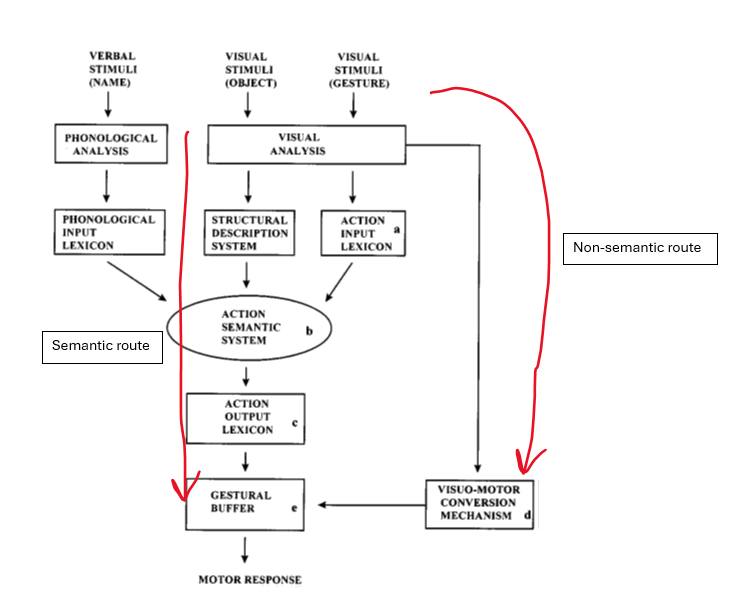
deficit in the action input lexicon (A)
causes problems in understanding seen gestures, but can perform them on verbal command and immitate them via the VMCM
deficit in the action semantic system (B)
causes problems in understanding gestures and inability to perform gestures via the semantic route, but can imitate them via the VMCM
deficits in the action output lexicon (C)
causes problems executing actions when directed, but can understand actions and mimic them via the VMCM
deficit in the visuo-motor conversion mechanism (VMCM) (E)
causes inability to imitate meaningful gestures but can perform on command / understand them
deficit in the gestural buffer (E)
causes impairment in all gestural executions but can understand them via the semantic system